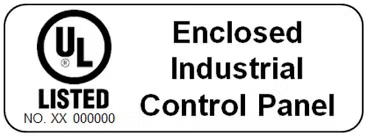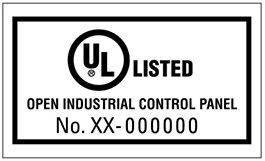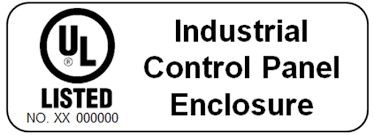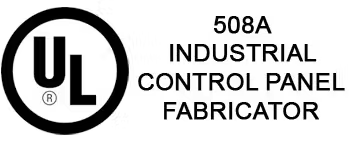UL Listed and CE marked, all c3controls products are designed to perform in a broad range of applications, making them suitable for use anywhere in the world.
Introduction
Underwriters Laboratories (UL) is a global safety certification company that sets rigorous standards for myriad industry components to meet.
Within the manufacturing sector, UL requirements help business leaders ensure safety, security, quality, confidence, and sustainability at every touchpoint.
With specific guidelines in place that dictate what tests to perform and metrics to meet, employees around the world are better able to identify discrepancies while ensuring performance levels remain high.
Today, we’re taking a closer look at the UL standards around industrial electrical control components. While end users should keep a full-length copy on hand to reference, we’ll provide a high-level overview of the major sections to initiate new users.
Ready to learn more? Let’s go!
UL 508A
As a certifying body, the UL has developed more than 800 standards for safety. To simplify the search process, UL breaks industry requirements into categories. You’ll find the UL standard for electrical controls in Section UL 508A.
The full edition is available here for purchase, but let’s take a look at the major points to keep in mind.
Scope of Section
At its core, UL 508A sets parameters for the design, control, and use of industrial control panels intended for general use within the industry.


Note that users can install a control panel in one of two ways. First, they can install it inside of an enclosure, which makes the panel an “enclosed type” of equipment.
Or, they can arrange the panel onto a mounting panel. This makes it a piece of “open type equipment.” In this case, the assembly fits into an enclosure that others provide, or it’s at the installation site.
With both installation formats, the following assumptions are in place from the onset:
- These systems will operate from a voltage of no more than 1,000 watts
- Users will install them in ordinary locations
- The installation will follow the National Electrical Code, ANSI/NFPA 70 standards
- The ambient temperature at the installation location is 40°C (104°F) or cooler
In addition to basic industrial control equipment, UL 508A also covers industrial control panel enclosures and control panels designed to support flame safety supervision over the following types of equipment:
- Combustible fuels
- Elevator controls
- Crane controls
- Hoist controls
- Air conditioning equipment
- Refrigeration equipment
- Load management components
- Fountain control
- Irrigation systems control
The standards also cover industrial machinery, such as:
- Metalworking machine tools
- Power press controls
- Plastic injection molding machinery
In terms of industrial control panel equipment, Standard 508A covers those installed to provide control of permanent electrical equipment found at:
- Packaging Material Handling Systems
- Burner and Burner Management Systems
- Automatic Car Washes
- Commercial and residential swimming pools and in-ground spas
- Pulp and Paper processing
- Water/Wastewater treatment facilities
- Irrigation systems
Component Requirements
Industrial control parts included under 508A include assemblies of two or more power circuit components. These can include:
- Motor controllers
- Overload relays
- Fused disconnect switches
- Circuit breakers
- Buttons, switches, timers, and controllers
- Wiring
- Terminals
- Enclosures
Or, they may consist of control circuit components, such as push-buttons, pilot lights, or control relays. The assemblies may also include a combination of power and control circuit components, along with all associated wiring and terminals.
Control Panel Components Not Evaluated
Note that while its list of inclusions is far-reaching, 508A does not cover evaluation of the equipment that the control panel controls, such as:
- Motors
- Lighting
- Heaters
- Loads connected to power circuits
In addition, the control panel is considered and evaluated on its own from any equipment mounted in a remote location away from it, even those connected via a wiring system. Likewise, it excludes any components that are field-installed on or within the control panel itself.
The UL evaluation standards also don’t extend to the adequacy of the controls and protective devices contained within the control panel. These are the components designed to supervise and ensure proper functioning of the controlled loads or equipment. In this case, the complete piece of utilization equipment has its own set of UL standards that users must locate and follow.
Finally, UL 508A doesn’t cover pre-fabricated buildings, structures, or any other platforms supplied alongside industrial control panels.
Structure of the Standard
The full UL 508A standard includes four sections:
Part 1: General Use
Part 2: Specific Use
Part 3: Specific Component Requirements
Part 4: Short Circuit Current Ratings
Related UL Standards for Industrial Controls
Though UL 508A is the most direct standard for control panel designs, it’s often listed and researched alongside other related UL standards for industrial controls. Some of the most common ones include:
- UL 218: Standard for Fire Pump Controllers
- UL 294: Standard for Access Control System Units
- UL 845: Standard for Motor Control Centers
- UL 864: Standard for Control Units and Fire Alarm System Accessories
- UL 891: Standard for Switchboards
- UL 916: Standard for Energy Management Equipment
- UL 924: Standard for Power Equipment and Emergency Lighting
- UL 1037: Standard for Anti-theft Alarms and Devices
- UL 1640: Standard for Portable Power-Distribution Equipment
Significance of the UL Listing Mark
Electrical inspectors will reference UL 508A when inspecting industrial control panels. If your equipment includes a UL 508A Listing Mark, you can rest assured that it’s passed certification by an independent, not-for-profit third party. It is appropriate and safe, meeting all required UL standards.
Both the municipal inspection authority and the buyer of the panel should look for this designation before making a purchase.
Before a control panel can carry the UL508A Listing Mark, it must include only UL-acknowledged and listed components. If a specific component has the UL Mark in place, it means that the UL evaluated and tested samples of it and deemed that it met its strict safety and security requirements.
Though tedious, this testing process ensures that every piece and part of the system possess the quality and integrity that the UL mandates for maximum quality and performance. You can look for the mark on both custom-built, one-of-a-kind control panels as well as standardized designs that have only undergone minor variations.
508A Certified Enclosures

When you select and purchase an enclosure that meets UL 508A specifications, you demonstrate to both the inspection authority and your end user that the control panel in question is in compliance with recognized safety standards.
These parameters are in place to ensure public safety. They also ensure the general public that the electrical control panel is in adherence to local and national electrical codes.
If you’re a control panel manufacturer, the certification holds a great degree of credence. These providers often receive periodic, unannounced visits and facility inspections by UL personnel. These regular audits help ensure that the manufacturer is up-to-date on all required UL requirements and that all components and panels continue to meet 508A certification measures.

General Enclosure Requirements
The UL 508A standard breaks the section into both general and outdoor-specific enclosure types. The general requirements have testing processes in place to ensure that all components include:
- Corrosion protection
- Support and securement for live parts
- Adequate spacings
- Conduit bushings
- Insulating barriers and materials
- Grounding
Outdoor-Specific Enclosure Requirements
For control panels within outdoor-specific enclosures, the UL standard dictates that these components include tests that ensure:
- Adequate enclosure openings
- Live parts accessibility
- Ventilation openings
- Enclosure environmental control devices
- Bonding
- Internal wiring
- Field wiring
- Brand circuit protection
- Disconnect switches
- Appropriate markings
UL 508A Changes in 2005
Change and innovation are necessary for industrial applications, and this extends to testing and verification procedures. The UL issued the first edition of 508A in April of 2001.
In September of 2005, UL 508A experienced a major revision that continues to affect manufacturers across multiple sectors.
In short, the change required that control panel builders include a short-circuit current rating on every control panel assembly.
Though this request is understandable and is an important safety consideration, it wasn’t a simple or easy practice to apply, at least not at first.
Why?
Though the UL has multiple methods in place to establish a short circuit rating, they aren’t all applicable to control panel builders. For instance, a straight short circuit test is effective but also expensive, and can damage equipment in the process.
Moreover, the calculation method requires specialized engineering and specific techniques that not every builder had access to.
As a result, control panel builders began working in tandem with component manufacturers, asking for tested device combinations, such as a circuit breaker or fuse and overload relay or contractor. The basic question they started asking was, “If I use motor starter A with circuit breaker B, what will the short circuit rating be?”
To facilitate these requests, manufacturers began creating databases and spreadsheets that detailed the different types of component combinations and their associated short circuit ratings. This made the research process quicker and more simple on the control panel builder’s end and helped ensure all parts were UL-compliant.
The only issue? It didn’t take long for the spreadsheets to challenge manufacturers. They become too large, especially given that there were thousands of ways that the different components could combine together in various functions.
UL Devises New Ratings Category
In response, the UL allowed manufacturers to develop a new category: component short circuit current ratings. This covered any part used in the power circuit of an industrial control panel.
In effect, this simplified the short circuit current ratings process and made it more generic. For instance, now manufacturers can label a motor starter as suitable for a circuit that is incapable of delivering more than “X” amps when used with a circuit breaker that doesn’t exceed “Y” amps.
A Note on UL 698A
The UL also has in place Standard 698A: Standard for Industrial Control Panels Relating to Hazardous (Classified) Locations.
These testing and verification requirements cover control panels intended for general industrial installation. They can range from unclassified locations with safe circuit extensions to the following hazardous and classified locations identified by the National Electrical Code (NEC), NFPA 70:
- Class I, Division 1
- Class I, Zone 0 and Zone 1 AEx
- Class II, Division 1
- Class III, Division 1
- Zone 20 and Zone 21 AEx
These components must operate within the following atmospheric conditions:
- Ambient temperature or 40°C (104°F) or cooler
- An oxygen concentration of 21% or less by volume
- Nominal barometric pressure of one atmosphere
698A Control Panel Types
Which industrial control panels most often fall into this category? Most assemblies will consist of components including:
- Motor controllers
- Overload relays
- Fused disconnect switches
- Circuit breakers
- Related control devices (e.g. push-button stations, selector switches, pilot lights, timers, control relays)
- Associated wiring terminals
In all of the above cases, the manufacturer will provide the enclosure as part of the total assembly.
698A Control Panel Features
Industrial control panels that fall into this UL category may also include the following features:
- Electrical or entity parameters
- An external interconnection to a non-specific simple apparatus
- Fieldbus intrinsically safe concept (FISCO) applications
- An external interconnection to specific simple apparatus and specific intrinsically safe apparatus
- An internal interconnection of multiple barriers
Keep in mind that the panels not included under standard 698A include:
- Electrostatic devices, circuits or systems
- Gas or vapor analysis equipment
- Equipment that includes a process line brought into the panel
Industrial Control Equipment Aligned with UL Standards
Looking for industrial control equipment that meets or exceeds all the UL standards listed herein? You’ve come to the right place.
When it comes to ensuring the quality, safety, integrity, and security of these mission-critical components, you can’t be too safe.
By requiring that all equipment aligns with UL testing and verification requirements, you demonstrate a commitment to user confidence, reliability, and overall performance.
That’s why we’re dedicated to products that contain the coveted UL Mark. Take a look at our online shop today to find the parts you need.
Any questions? Feel free to contact us. We’re as committed to quality as you are and we’ll make sure you’re satisfied.
Disclaimer:
The content provided is intended solely for general information purposes and is provided with the understanding that the authors and publishers are not herein engaged in rendering engineering or other professional advice or services. The practice of engineering is driven by site-specific circumstances unique to each project. Consequently, any use of this information should be done only in consultation with a qualified and licensed professional who can take into account all relevant factors and desired outcomes. The information was posted with reasonable care and attention. However, it is possible that some information is incomplete, incorrect, or inapplicable to particular circumstances or conditions. We do not accept liability for direct or indirect losses resulting from using, relying or acting upon information in this blog post.
ISO 9001:2015
Certified
17+ Million Product
Configurations
Lifetime
Warranty
Guaranteed
Same-Day Shipping
Advantage Pricing
Save Up To 40%
c3controls Headquarters, USA
664 State Avenue
Beaver, PA 15009
